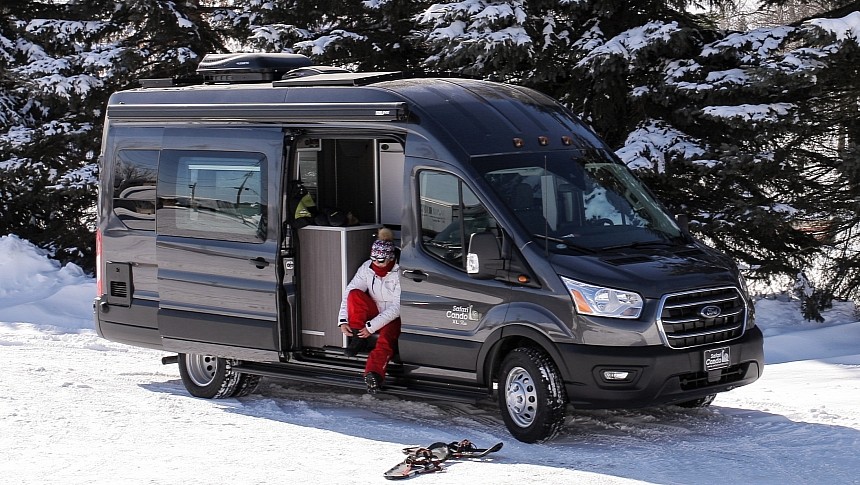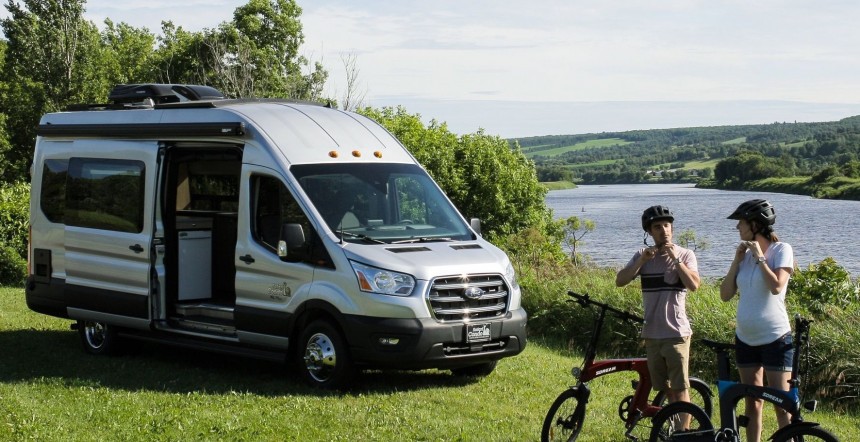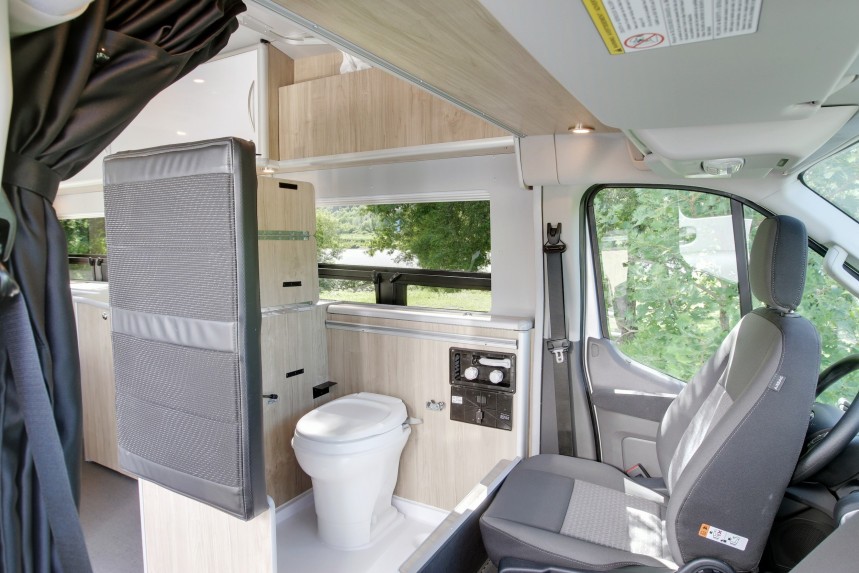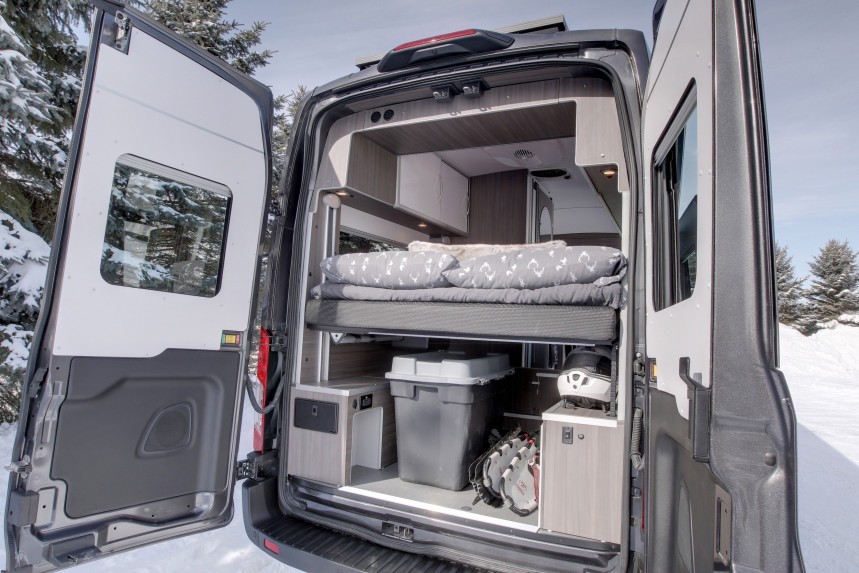RVs come in all shapes and sizes, but one of the currently fastest growing trends seems to be camper vans, and Canada's Safari Condo knows this because here we are, staring down the tailpipe of two ravishing Ford Transit models.
Folks, if the name Safari Condo sounds familiar, it might be because we've covered this crew's work on several occasions; recently, their "most aerodynamic" A Series travel trailer was the object of discussion. Well, this time, we stray from travel trailer living and right into a fully-equipped Class B RV. This brings us to the two Ford Transit layouts that Safari Condo currently offers, the XL Plus and XL Flex.
For starters, each of the two available floorplans is based upon the Series 3500 Transit with a GVWR of 5,000 kg (11,023 lbs) and rocking a 3.5L Turbo EcoBoost engine. Optionally, you can go for an AWD version if you and your adventures ask for more traction and control.
With a base vehicle chosen for this RV dream, Safari Condo then goes to town crafting an interior that, surprisingly, includes all the features and systems you need to live life on the road. Funny enough, not only for short periods of time but year-round living. If you're planning on unedited ski trips, do look into that AWD option.
Now, from the outside, this Transit may end up looking just like any other campervan on the market, so the only real way that Safari Condo can stand apart from other teams and gun for your money is with a unique interior design, and frankly, this is the one big reason why I chose to bring this lineup to light; I'm more of a Sprinter fan.
Since Safari Condo is a Canadian crew, it's really nice to see them incorporating design cues and features similar to what we see in campervans overseas, in Europe, to be precise. I'm talking about flawless countertops, LED lighting, smart use of compartments all over, and an open feeling to the enclosure, even though you're literally crammed inside a box on wheels. Not to mention, just about every inch of these buggers are modular.
For example, the Plus showcases an interesting dinette design. During day-to-day activities, two tables and a bench are spotted making up the area. However, this is also the friggin bathroom! At a moment's notice, you'll lift the seating and backrest, and before you know it, you're looking at a hidden toilet and, above all, the ability to shower; just pull back the curtains and don't worry about flooding your interior.
Also in the Plus, the rear seating bench is to be used as nothing more than a bed when the day comes to a close, and this is also one way the Plus and Flex differ. As I explored the images on the manufacturer's website, I noticed that the Flex has an electric elevating bed in the process of creating one heck of a cargo hold. If you're looking to bring along some e-bikes, skis, and even some inflatable kayaks, the Flex might be the unit you want. Oh, and don't worry, the Flex also hides a wet bath, but it just might not be as comfortable as the one in the Plus.
Another big difference between the two models is the overall interior arrangement. For instance, the Plus has the galley and countertop space sitting on the port side of the unit, while the Flex places it along the starboard side. The trick now is finding the unit that best suits your lifestyle, and to do that, you have to ask yourself some questions.
For instance, if you're planning on living and working out of your XL, the Plus is the one you want. Yet, if you're looking for a unit to use for adventurous days and toy-filled adventures, you might want to look into the Flex.
Yet, no matter which of these two-wheeled homes you end up choosing, some basics, like the two-burner top, Truma water heater, oven, and fridge, are available in both options. Not to mention two 100 Ah batteries, a 2,000 W inverter, and monitor panels for tanks and electrical. Solar panels are going to run you extra. Want a roof rack? That's possible, too. I wonder if you can drop a rooftop tent into this one.
The question that remains now is just how much we need to get our hands on one of these. Well, the least expensive of the bunch is the Plus, and it starts off at no less than $144,779. But don't lose your lunch just yet because that's a price in Canadian dollars. In reality, it's around $107,500 American (at current exchange rates).
Some of us may frown upon that number, but please consider that you're buying a full-time RV and one that can handle just about anything your life throws at it. Sure, it's no overlander, but it doesn't need to be. After all, very few of us are into that pastime. As for the Flex, it can be spotted starting at around $110,800 American. Just something to consider if you've been planning on getting your hands on a Class B RV for this season and countless others to follow.
For starters, each of the two available floorplans is based upon the Series 3500 Transit with a GVWR of 5,000 kg (11,023 lbs) and rocking a 3.5L Turbo EcoBoost engine. Optionally, you can go for an AWD version if you and your adventures ask for more traction and control.
With a base vehicle chosen for this RV dream, Safari Condo then goes to town crafting an interior that, surprisingly, includes all the features and systems you need to live life on the road. Funny enough, not only for short periods of time but year-round living. If you're planning on unedited ski trips, do look into that AWD option.
Since Safari Condo is a Canadian crew, it's really nice to see them incorporating design cues and features similar to what we see in campervans overseas, in Europe, to be precise. I'm talking about flawless countertops, LED lighting, smart use of compartments all over, and an open feeling to the enclosure, even though you're literally crammed inside a box on wheels. Not to mention, just about every inch of these buggers are modular.
For example, the Plus showcases an interesting dinette design. During day-to-day activities, two tables and a bench are spotted making up the area. However, this is also the friggin bathroom! At a moment's notice, you'll lift the seating and backrest, and before you know it, you're looking at a hidden toilet and, above all, the ability to shower; just pull back the curtains and don't worry about flooding your interior.
Another big difference between the two models is the overall interior arrangement. For instance, the Plus has the galley and countertop space sitting on the port side of the unit, while the Flex places it along the starboard side. The trick now is finding the unit that best suits your lifestyle, and to do that, you have to ask yourself some questions.
For instance, if you're planning on living and working out of your XL, the Plus is the one you want. Yet, if you're looking for a unit to use for adventurous days and toy-filled adventures, you might want to look into the Flex.
The question that remains now is just how much we need to get our hands on one of these. Well, the least expensive of the bunch is the Plus, and it starts off at no less than $144,779. But don't lose your lunch just yet because that's a price in Canadian dollars. In reality, it's around $107,500 American (at current exchange rates).
Some of us may frown upon that number, but please consider that you're buying a full-time RV and one that can handle just about anything your life throws at it. Sure, it's no overlander, but it doesn't need to be. After all, very few of us are into that pastime. As for the Flex, it can be spotted starting at around $110,800 American. Just something to consider if you've been planning on getting your hands on a Class B RV for this season and countless others to follow.




















